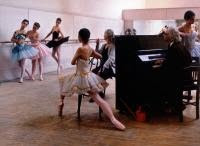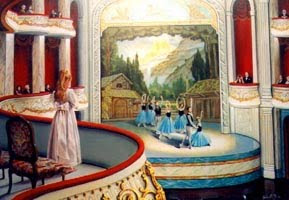1. Plaintiff Douglas Hofmann is a fine art painter who works from photographs. Hofman staged numerous photographs involving ballet dancers. He intended to paint fine art works from the photographs. A low res example of Hofman's work from his website.
Douglas Hofmann Master Class
2. John O'Brien is a deceased fine art painter. During his lifetime he took one of Hofmann's photographs without Hofmann's permission and created a painting from the photograph that was essentially a copy. His widow, Mary O'Brien posted an image of O'Brien's painting on his website and offered prints for sale. An example of O'Brien's work:
John O'Brien Her First Ballet
3. A trial was held. The jury awarded $201,550 in actual damages based on claims of conversion and copyright infringement. Hofmann's out of pocket costs to create the photograph were $1,550.
The main issue before the court was whether the jury instructions on damages were correct and whether the jury's damage award was supported by the evidence. Since the photograph was presumably not registred timely, Hofmann was forced to prove "actual damages" under Section 504(b) of the Copyright Act. Section 504(b) states:
(b) Actual Damages and Profits. — The copyright owner is entitled to recover the actual damages suffered by him or her as a result of the infringement, and any profits of the infringer that are attributable to the infringement and are not taken into account in computing the actual damages. In establishing the infringer's profits, the copyright owner is required to present proof only of the infringer's gross revenue, and the infringer is required to prove his or her deductible expenses and the elements of profit attributable to factors other than the copyrighted work.
The Fourth Circuit found that the artist had not proved actual damages sufficient to support the jury's award and reversed for remittitur or trial.
Cases throwing out testimony relating to actual damages of a copyright are legion and proof of actual damages is notoriously difficult. As the Fourth Circuit cautions "General claims of 'hurt feelings' or an owner's 'personal objections to the manipulation of his artwork' must not enter into the calculus'
[quoting Mackie v. Reiser, 296 F.3d 909, 917 (9th Cir. 2002)].
The decision doesn't tell us whether the widow knew that the work was infringing - a widow is not generally the best defendant, no matter what the merits of your case are.
This case reinforces the importance for artists of promptly registering copyrights with the Copyright Office so that they may be entitled to statutory damages and attorneys fees. I discuss these issues further in Copyright Litigation Handbook - Chapter 15 - Evidence and Experts); Chapter 16 - Jury Instructions; Chapter 17 - Damages and Profits; and Chapter 18 - Costs and Attorneys Fees.


No comments:
Post a Comment